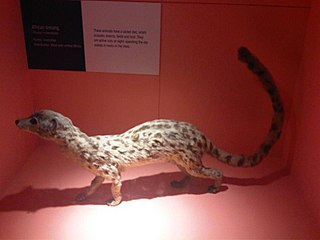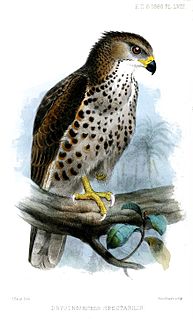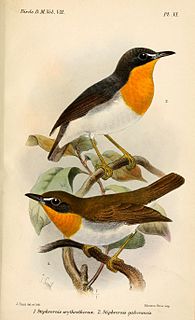
The Guinea turaco, also known as the green turaco or green lourie, is a species of turaco, a group of otidimorphae birds belonging to the family Musophagidae. It was formerly included in the Livingstone's, Schalow's, Knysna, black-billed and Fischer's turacos as subspecies.

The red-bellied paradise flycatcher, also known as the black-headed paradise flycatcher, is a medium-sized passerine bird of the family of monarch flycatchers. It is native to intra-tropical forests of Africa. The male bird is about 17 cm (7 in) long and has a black head, a mainly chestnut body, and a tail with streamers nearly twice as long as the body. The colouring is somewhat variable across the bird's range. Both females and juveniles lack the tail streamers and are a duller brown colour. It is closely related to the African paradise flycatcher, and the two can hybridise.

The Central African oyan, also called Central African linsang, is a linsang species native to Central Africa.

The black-capped lory also known as western black-capped lory or the tricolored lory, is a parrot found in New Guinea and adjacent smaller islands. It is a colourful and relatively robust lory. There are seven subspecies, all with green wings, red heads and body around the wing, a black cap, grey-black cere, yellow underwings, and blue legs and belly. Most also have a blue nape and mantle. It remains overall widespread and common, but the subspecies cyanuchen is relatively rare, with fewer than 5,000 individuals remaining.

The Congo serpent eagle is a species of bird of prey in the family Accipitridae. It is the only member of the monotypic genus Dryotriorchis, although it was formerly placed in Circaetus. This species is distributed across the African tropical rainforest, including upper and lower Guinean forests. This serpent eagle specializes in hunting in these forests’ dark understories. It has two subspecies, the nominate subspecies Dryotriorchis spectabilis spectabilis and Dryotriorchis spectabilis batesi. Though monotypic, it appears to be very closely related to Circaetus. This hawk is a medium-sized bird with distinctive short, rounded wings and a long, rounded tail. It is varying shades of brown on its back and has a slight crest. Its breast is white with variable amounts of a rufous wash and, in the nominate subspecies, is covered in round, blackish spots. The subspecies D. s. batesi only has these dots on its flanks. The Congo serpent eagle closely resembles Cassin's hawk-eagle, and some ornithologists believe that this likeness is a rare example of avian mimicry. It is a very vocal raptor, and often is one of the most heard species in its habitat.

The slender-billed greenbul is a species in the monotypic genus Stelgidillas of the bulbul family of passerine birds. It is found in western and central Africa. Its natural habitats are subtropical or tropical dry forest, subtropical or tropical moist lowland forest, and subtropical or tropical moist montane forest.

The little grey greenbul is a species of the bulbul family of passerine birds. It is widely distributed across the African tropical rainforest. Its natural habitats are subtropical or tropical moist lowland forests and subtropical or tropical swamps.

The little greenbul is a species of the bulbul family of passerine birds. It is found in many parts of sub-Saharan Africa.

Cabanis's greenbul, also known as Cabanis's bulbul, is a species of songbird in the bulbul family, Pycnonotidae. It is found in east-central and south-central Africa. Its natural habitats are subtropical or tropical dry forest, subtropical or tropical moist lowland forest, subtropical or tropical moist montane forest, and subtropical or tropical moist shrubland.

The brown-hooded kingfisher is a species of bird in the subfamily Halcyoninae, the tree kingfishers. It has a brown head and blackish and turquoise wings. It is found in Sub-Saharan Africa, living in woodland, scrubland, forest edges, and also suburban areas. The International Union for Conservation of Nature (IUCN) has assessed it as being of least concern.

The olive-green camaroptera is a bird species in the family Cisticolidae.

Monteiro's bushshrike is a species of bird in the bush-shrike family (Malaconotidae).

The white-starred robin is a species of bird in the Old World flycatcher and chat family Muscicapidae. It is also sometimes more simply called the starred robin. It is monotypic within the genus Pogonocichla. There are around twelve subspecies. The species is found in East and southern Africa. It is a forest species, occurring in montane forest in the north of its range but closer to sea level further south. This is a brightly coloured robin with a bright yellow breast and belly, a slate coloured head with spots on the eyes and throat and blueish wings.
The brown-headed apalis is a small passerine bird belonging to the genus Apalis in the family Cisticolidae. Formerly included within the grey apalis but is now commonly considered to be a separate species. It has two subspecies: A. a. alticola and A. a. dowsetti

The olive-backed forest robin is a subspecies of the forest robin found in the Gamba Complex in southwest Gabon. It was described in 2008. The olive-backed forest robin can be separated from other subspecies of the forest robin by the combination of its olive upperparts, bright orange throat and chest, and cream-yellow belly. Its song is also distinct from other subspecies of the forest robin. Females are generally duller than males. It has not been evaluated by IUCN, but has been described as locally common.

The western forest robin is a subspecies of the forest robin found at low levels in West African forests from Sierra Leone to Nigeria. It has been placed in the family Turdidae, but is now generally placed in Muscicapidae. It commonly includes the other members in the genus Stiphrornis as subspecies, in which case the common name for the "combined species" simply is forest robin. The western forest robin can be separate from the other members of the genus by the combination of its deep orange throat and breast, white belly, and olive upperparts. It also appears to differ vocally from the other members in the genus, but a comprehensive study on this is lacking. When considered conspecific with the other members from its genus, S. erythrothorax is considered to be of least concern by IUCN. While not rated following the split into several species, it has been described as frequent to locally abundant, and is therefore unlikely to qualify for a threatened category.

The forest robin or orange-breasted forest robin is a species of bird from Central and West Africa. It is monotypic in the genus Stiphrornis. It has been placed in the family Turdidae, but is now generally placed in Muscicapidae in the group popularly known as chats. Most taxonomists consider it a single species, but some reviews have recommended recognizing 5 species. It has a total length of around 12 cm, has dark upperparts, and a throat and chest that, depending on the subspecies, is yellow-orange or deep orange.

The Gabon forest robin is a subspecies of the forest robin found at low levels of forests in Cameroon, Gabon and Bioko. In 1999 it was recommended that it should be treated as a separate species instead of a subspecies. IUCN and some other authorities do not recognize the split, and consequently it has not been rated as species separate from the forest robin. However, it has been described as frequent to locally abundant, and is therefore unlikely to qualify for a threatened category.

The eastern forest robin is a subspecies of the forest robin found at low levels in forests from Cameroon and Gabon to DR Congo and Uganda. In 1999 it was recommended that it should be treated as a separate species instead of a subspecies. IUCN and some other authorities do not recognize the split, and consequently it has not been rated as species separate from S. erythrothorax. However, it has been described as frequent to locally abundant, and is therefore unlikely to qualify for a threatened category.
The Dzanga-Ndoki National Park is located in the southwestern extremity of the Central African Republic. Established in 1990, the national park is 1,143.26 square kilometres (441.42 sq mi). The national park is split into two non-continuous sectors, the northern Dzanga sector 49,500 ha and the southern Ndoki sector 72,500 ha. Notable in the Dzanga sector is a gorilla density of 1.6/km2 (4.1/sq mi), one of the highest densities ever reported for the western lowland gorilla.















